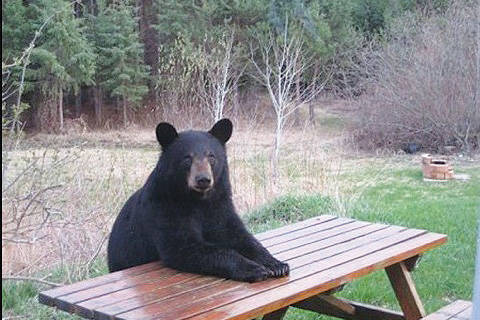As the weather warms, a familiar fear starts to resurface — bears.
“We get so complacent in the winter,” said Kenai Wildlife Refuge Wildlife Biologist Todd Eskelin. “Even if it’s just a bag of dog food we leave on the porch, this time of year there’s not a lot of food for them.”
As brown and black bears start to wake up from months of hibernation, residents of the Kenai Peninsula need to revert back to their ‘bear aware’ state. There have been a few sightings throughout the peninsula, including a brown bear harvest near Deep Creek last month. The snow has melted and, according to Eskelin, there is no reason why the bears aren’t out.
“It’s going to be a while until moose calves are around and most of the vegetation isn’t popping out yet,” Eskelin said. “A lot of bears will go to south-facing slopes, where they get that new vegetation. If they find their way to residential areas, though, they certainly will target whatever they can find. We get so lazy, we haven’t done the bear aware approach to the summer yet. It’s not until they start having problems and at that point it’s a little too late.”
Bears have an excellent memory, according to the Refuge, and once they identify a place with food they will return to look for it again and again.
Eskelin, who was recently certified as a hummingbird tagger, recommends taking down any bird feeders that may be within bear range, but with the caveat that second story feeders should be safe.
“I’m kind of encouraging people, if they do have a safe place, to put up hummingbird feeders,” Eskelin said. “I’m all for it, because it’s the one way I’ll be able to tag hummingbirds. But be sure to hang it somewhere bears can’t get to. I would only encourage that in situations where people can safely hang them.”
On trails, it’s important to continually make noise by singing, loudly talking, or carrying a bear bell, to alert bears to your presence and give them enough time to clear the area.
“Bears are most likely to charge when they feel threatened or when their “space” has been invaded,” according the the Refuge. “Avoid areas where bears are likely to be looking for food, such as streams containing spawning salmon and berry patches. If you come across an animal carcass, leave the area.”
When camping, camp at least 200 yards from the trails since bears are known to use the same trails as people. Choose a camping spot with good visibility. Cook food 200 yards downwind from your tent site, keep your camping and cooking gear clean and store all food and garbage in airtight containers, either 200 yards from your tent or hanging in a tree.
Bear encounters do happen, despite following all necessary precautions, but how a person reacts could save their life.
“Never run from a bear; the bear might perceive you as prey and follow in pursuit. Instead, wave your arms, talk to the bear and identify yourself as human. Slowly back off, and avoid eye contact with the bear, which the bear may see as a challenge,” according to the refuge. “If the bear should approach you, stand still; a bear may often bluff charge and come to within 10 feet of a person and then back off.”
If a bear attack does happen, the best response is to curl up in a ball with your hands clasped behind your neck.
With less snow and more foot traffic on the trails, it’s important to be bear aware.

